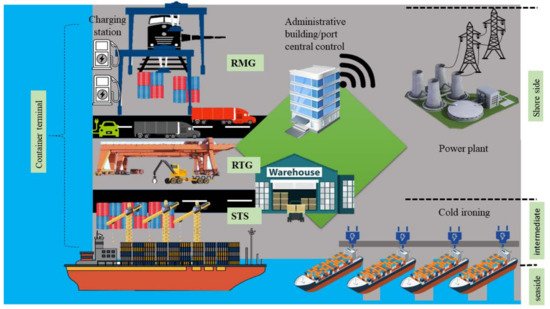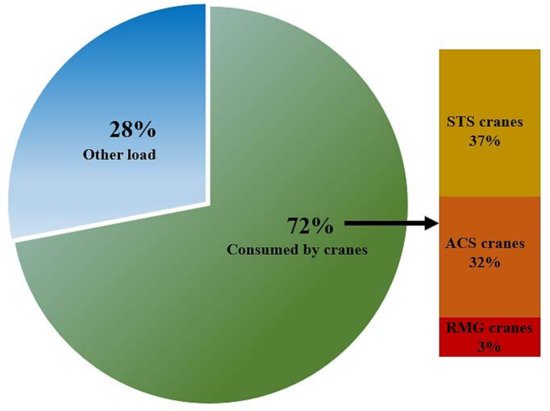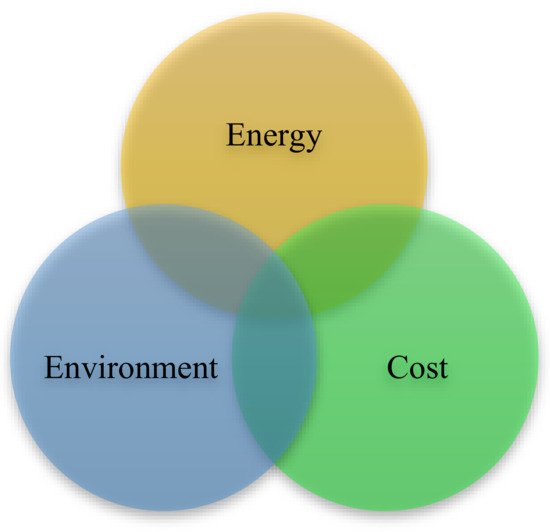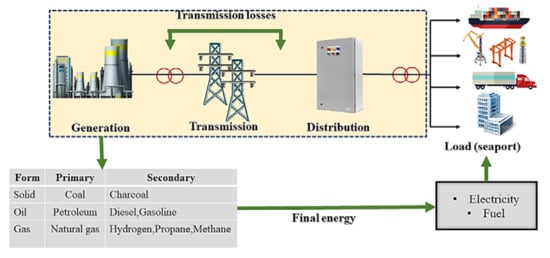Seaports are well known as the medium that has evolved into the central link between sea and land for complex marine activities. The growth in maritime logistics particularly necessitates a large volume of energy supply in order to maintain the operation of sea trade, resulting in an imbalance between generation and demand sides. Future projections for three major concerns show an increase in load demand, cost of operation, and environmental issues. The involvement of a variety of heavy loads such as all-electric ships, cranes, cold ironing, and buildings infrastructure renders it a complicated arrangement task in several aspects, which necessitates further research and leaves space for improvement.
- Port Activities
- Seaports
- Maritime
- Seaport load
- Seaport energy revolution
- Maritime Policy
- Electrification
- Port classification
1. Port Activities and Power Consumers
| Port Type | Characteristics |
|---|---|
| Local port | Serves for local needs Limited space and capacity Small size No logistic activity handling Do not support cruise ships Boats, vessels, yachts, and small-sized ships < 500 passengers |
| National port | Serves country needs Medium-sized (larger than local port) Cover all ships type with small logistic and cruise activities Medium-sized ships < 2500 passengers, cargo (packages), and logistics (only trucks) |
| International port | Serves international needs Largest sized Provide huge logistic infrastructure Cruise ships > 2500 passengers, cargo, containerships, and RTG cranes |


| Seaport’s Services | Load | Factor Influence Energy Consumption | Load Classifications | Form of Energy |
|---|---|---|---|---|
| Vessel | Passenger ships (cruise, ferry), container ships, electric ships, tugs, gliders, bunkers, boats, tankers, hovercraft, sailboats, submarines, yachts | Size of the ship, activity conduct on the ship, time of operation, weather, wave, speed |
|
|
| Goods handling | Cargo, container, quay, logistic, freight forwarder, customs warehouse, storage, security, loading-unloading | Number of cranes, amount of cargo, hours of operation | ||
| Administration | Management and administrative building, planning, service solution, IT, monitoring | Type of electrical equipment, weather, building material, hours of operation, occupant behavior | ||
| Transportation | Electric vehicles, cranes, trucks, yard tractors, trains | Number of transportation, hours of consumption | ||
| Electric Facility | Cold ironing, charging station for electric vehicles | Time of berthing, number of ships per berthing, size, and ship’s load | ||
| Maintenance | Repair and maintenance | Type of the maintenance |
2. Port Critical Concerns and Green Maritime Policy


| Date | Sulfur Limit in Fuel (% m/m) | |
|---|---|---|
| SOx ECA | Global | |
| 2000 | 1.5 | 4.5 |
| 2010 | 1.0 | |
| 2012 | 3.5 | |
| 2015 | 0.1 | |
| 2020 | 0.5 | |
| Country | Legislation |
|---|---|
| EU | Classification Societies—Regulation (EC) No 391/2009; Ship-Source Pollution—Directive 2000/59/EC; Marine Equipment—Directive 96/98/EC and Directive 2014/90/EU |
| Australia | Environmental Protection Act 1986 (WA) |
| New Zealand | Resource Management (Marine Pollution) Regulations |
| USA | Diesel Emission Reduction Act (DERA) |
| Singapore | Environmental Protection and Management Act (Cap.94A) |
3. Seaport Energy Revolution
3.1. Conventional System

| No | Variant | Sulfur Content |
|---|---|---|
| 1 | High Sulfur Fuel Oil (HSFO) | 3.5% |
| 2 | Low Sulfur Fuel Oil (LSFO) | 1.0% |
| 3 | Ultra-Low Sulfur Fuel Oil (ULSO) | 0.1% |
3.2. Ports and Ships Electrification
This entry is adapted from the peer-reviewed paper 10.3390/en14237941
References
- De Langen, P.W. Governance in Seaport Clusters; Palgrave Macmillan: London, UK, 2015; pp. 138–154.
- Hlali, A.; Hammami, S. Seaport concept and services characteristics: Theoretical test. Open Transp. J. 2018, 11, 120–129.
- Versteegt, G. Berthing Loads in Strcutural Design; Delft University of Technology: South Holland, The Netherlands, 2013.
- Bintiahamad, N.B. Integration of Microgrid Technologies in Future Seaports. 2019. Available online: https://www.forskningsdatabasen.dk/en/catalog/2471559831 (accessed on 20 July 2021).
- De Langen, P.W.; Sharypova, K. Intermodal connectivity as a port performance indicator. Res. Transp. Bus. Manag. 2013, 8, 97–102.
- Sifakis, N.; Tsoutsos, T. Planning zero-emissions ports through the nearly zero energy port concept. J. Clean. Prod. 2021, 286, 125448.
- Abu Bakar, N.N.; Hassan, M.Y.; Abdullah, H.; Rahman, H.A.; Abdullah, M.P.; Hussin, F.; Bandi, M. Energy efficiency index as an indicator for measuring building energy performance: A review. Renew. Sustain. Energy Rev. 2015, 44, 1–11.
- Zhao, H.X.; Magoulès, F. A review on the prediction of building energy consumption. Renew. Sustain. Energy Rev. 2012, 16, 3586–3592.
- Binti Ahamad, N.B.; Su, C.L.; Zhaoxia, X.; Vasquez, J.C.; Guerrero, J.M. Modeling and controls of flywheel energy storage systems for energy harvesting from harbor electrical cranes. In Proceeding of the 2018 IEEE Industry Applications Society Annual Meeting (IAS), Portland, OR, USA, 23–27 September 2018; pp. 1–8.
- Comer, B.; Olmer, N.; Mao, X.; Roy, B.; Rutherford, D. Prevalence of Heavy Fuel Oil and Black Carbon in Arctic Shipping, 2015 to 2025; International Council on Clean Transportation (ICCT): Washington, DC, USA, 2017; p. 68. Available online: https://www.theicct.org/publications/prevalence-heavy-fuel-oil-and-black-carbon-arctic-shipping-2015-2025 (accessed on 25 June 2021).
- Yiğit, K.; Kökkülünk, G.; Parlak, A.; Karakaş, A. Energy cost assessment of shoreside power supply considering the smart grid concept: A case study for a bulk carrier ship. Marit. Policy Manag. 2016, 43, 469–482.
- Thongam, J.S.; Tarbouchi, M.; Okou, A.F.; Bouchard, D.; Beguenane, R. All-electric ships—A review of the present state of the art. In Proceeding of the 2013 Eighth International Conference and Exhibition on Ecological Vehicles and Renewable Energies (EVER), Monte Carlo, Monaco, 27–30 March 2013; pp. 1–8.
- Mutarraf, M.U.; Terriche, Y.; Nasir, M.; Guan, Y.; Su, C.L.; Vasquez, J.C.; Guerrero, J.M. A Decentralized control scheme for adaptive power-sharing in ships based seaport microgrid. In Proceeding of the IECON 2020 the 46th Annual Conference of the IEEE Industrial Electronics Society, Singapore, 18–21 October 2020; pp. 3126–3131.
- Ahamad, N.B.B.; Guerrero, J.M.; Su, C.L.; Vasquez, J.C.; Zhaoxia, X. Microgrids technologies in future seaports. In Proceeding of the 2018 IEEE International Conference on Environment and Electrical Engineering and 2018 IEEE Industrial and Commercial Power Systems Europe (EEEIC/I&CPS Europe), Palermo, Italy, 12–15 June 2018; pp. 1–6.
- Boile, M.; Theofanis, S.; Sdoukopoulos, E.; Plytas, N. Developing a port energy management plan: Issues, challenges, and prospects. Transp. Res. Rec. 2016, 2549, 19–28.
- Kusuma, L.T.W.N.; Tseng, F.S. Analysis of the impact of the “sea toll” program for seaports: Resilience and competitiveness. Appl. Sci. 2019, 9, 3407.
- Sadiq, M.; Ali, S.W.; Terriche, Y.; Mutarraf, M.U.; Hassan, M.A.; Hamid, K.; Ali, Z.; Sze, J.Y.; Su, C.-L.; Guerrero, J.M. Future greener seaports: A review of new infrastructure, challenges, and energy efficiency measures. IEEE Access 2021, 9, 75568–75587.
- Port of Wilmington Cold Storage Becomes First in-Port Cold Storage Facility in North Carolina. Available online: https://www.provisioneronline.com/articles/104257-port-of-wilmington-cold-storage-becomes-first-in-port-cold-storage-facility-in-north-carolina (accessed on 23 July 2021).
- Mostafa, K.; Giuseppe, P.; Ben, C.; Luigi, M. Ultracapacitors for port crane applications: Sizing and techno-economic analysis. Energies 2020, 13, 2091.
- Kermani, M.; Parise, G.; Martirano, L.; Parise, L.; Chavdarian, B. Optimization of peak load shaving in STS group cranes based on pso algorithm. In Proceeding of the 2018 IEEE International Conference on Environment and Electrical Engineering and 2018 IEEE Industrial and Commercial Power Systems Europe (EEEIC/I&CPS Europe), Palermo, Italy, 12–15 June 2018.
- Hariharan, R.; Usha Rani, P.; Muthu Kannan, P. Sustain the critical load in blackout using virtual instrumentation. In Intelligent and Efficient Electrical Systems; Springer: Singapore, 2018; pp. 77–88.
- Pei, R.; Xie, J.; Zhang, H.; Sun, K.; Wu, Z. Robust multi-layer energy management and control methodologies for reefer container park in port terminal. Energies 2021, 14, 4456.
- Rosa Mari Darbra, M.P.; Wooldridge, C. ESPO Environmental Report 2020. 2020. Available online: https://www.espo.be/media/EnvironmentalReport-WEB-FINAL.pdf (accessed on 23 July 2021).
- Hein, K.; Xu, Y.; Gary, W.; Gupta, A.K. Robustly coordinated operational scheduling of a grid-connected seaport microgrid under uncertainties. IET Gener. Transm. Distrib. 2021, 15, 347–358.
- Zhang, X. Analysis of the Incentives in Environmental Strategies Implementation in Chinese Ports. Master’s Thesis, Erasmus University Rotterdam, Rotterdam, The Netherlands, 2016; pp. 1–76.
- Endresen, Ø.; Sørgård, E.; Sundet, J.K.; Dalsøren, S.B.; Isaksen, I.S.A.; Berglen, T.F.; Gravir, G. Emission from international sea transportation and environmental impact. J. Geophys. Res. Atmos. 2003, 108, 14–21.
- IMO. IMO 2020—Cutting Sulphur Oxide Emissions. Available online: https://www.imo.org/en/MediaCentre/HotTopics/Pages/Sulphur-2020.aspx (accessed on 8 August 2021).
- Acciaro, M.; Ghiara, H.; Inés, M.; Cusano, M.I. Energy management in seaports: A new role for port authorities. Energy Policy 2014, 71, 4–12.
- Roh, S.; Thai, V.V.; Wong, Y.D. Towards sustainable asean port development: Challenges and opportunities for vietnamese ports. Asian J. Shipp. Logist. 2016, 32, 107–118.
- Edoho, F.M. Oil transnational corporations: Corporate social responsibility and environmental sustainability. Corp. Soc. Responsib. Environ. Manag. 2008, 15, 210–222.
- Matishov, G.G.; Selifonova, Z.P. New scientifically based methods for controlling ship ballast in ports. Dokl. Biol. Sci. 2008, 422, 342.
- Behrends, B.; Liebezeit, P.G.; Gregory, D. Reducing SO2 and NOX Emissions from Ships by a Seawater Scrubber; BP Marine Report; Research Centre Terramare: Wilhelmshaven, Germany, 2003; pp. 11–64.
- Fouquet, R. Energy Research & social science historical energy transitions: Speed, prices and system transformation. Chem. Phys. Lett. 2016, 22, 7–12.
- Heavy Fuel Oil. 2015. Available online: https://www.oiltanking.com/en/news-info/glossary/details/term/heavy-fuel-oil-hfo.html (accessed on 15 August 2021).
- Papoutsoglou, T.G. A Cold Ironing Study o Modern Ports, Implementation and Benefits Thriving for Worldwide Ports. Bachelor’s Thesis, Marine Engineering National Technical University of Athens, Zografou, Greece, 2012.
- Innes, A.; Monios, J. Identifying the unique challenges of installing cold ironing at small and medium ports—The case of aberdeen. Transp. Res. Part D Transp. Environ. 2018, 62, 298–313.
- Mutarraf, M.U.; Terriche, Y.; Nasir, M.; Guan, Y.; Su, C.-L.; Vasquez, J.C.; Guerrero, J.M. A communication-less multi-mode control approach for adaptive power-sharing in ships-based seaport microgrid. IEEE Trans. Transp. Electrif. 2021, 7, 3070–3082.
- Mocci, S.; Porru, M.; Serpi, A.; Soma, G.G. The poseidon project: Microgrid in port areas to improve energy efficiency by the integration of res, flexible loads and smart mobility. In Proceeding of the 2019 1st International Conference on Energy Transition in the Mediterranean Area (SyNERGY MED), Cagliari, Italy, 28–30 May 2019; pp. 1–5.
- Salleh, N.A.S.; Muda, W.M.W.; Abdullah, S.S. Feasibility study of optimization and economic analysis for grid-connected renewable energy electric boat charging station in Kuala Terengganu. In Proceeding of the 2015 IEEE Conference on Energy Conversion (CENCON), Johor Bahru, Malaysia, 19–20 October 2015; pp. 510–515.
- Roy, A.; Auger, F.; Olivier, J.; Schae, E.; Auvity, B. Design, Sizing, and Energy Management of Microgrids in Harbor Areas: A Review. Energies 2020, 13, 5314.
- Soh, A. Jurong Port Starts World’s Largest Port-Based Solar Facility. 2016. Available online: https://www.businesstimes.com.sg/energy-commodities/jurong-port-starts-worlds-largest-port-based-solar-facility (accessed on 23 August 2021).
- Port of Aalborg Becomes the First co2 Neutral Port in Denmark. Available online: https://safety4sea.com/port-of-aalborg-becomes-the-first-co2-neutral-port-in-denmark/ (accessed on 23 August 2021).
- Shahidehpour, M.; Clair, J.F. A functional microgrid for enhancing reliability, sustainability, and energy efficiency. Electr. J. 2012, 25, 21–28.
- Vicenzutti, A.; Bosich, D.; Giadrossi, G.; Sulligoi, G. The role of voltage controls in modern all electrical ships toward the all-electric ship. IEEE Electrif. Mag. 2015, 3, 49–65.
- McCoy, T.J. Electric ships past, present, and future . IEEE Electrif. Mag. 2015, 3, 4–11.
- Murphy, J.F.H.M.; May, J.; Riksheim, R. International Cooperation on Marine Engineering Systems/Electric Propulsion—State-of-the-art and Trends in Electric Power Generation, Distribution, and Propulsion, and Their Associated Control Systems Report from Technical Committee B: Electric Pr. 2000; pp. 1–36.
- Fang, S.; Wang, Y.; Gou, B.; Xu, Y. Toward future green maritime transportation: An overview of seaport microgrids and all-electric ships. IEEE Trans. Veh. Technol. 2020, 69, 207–219.
